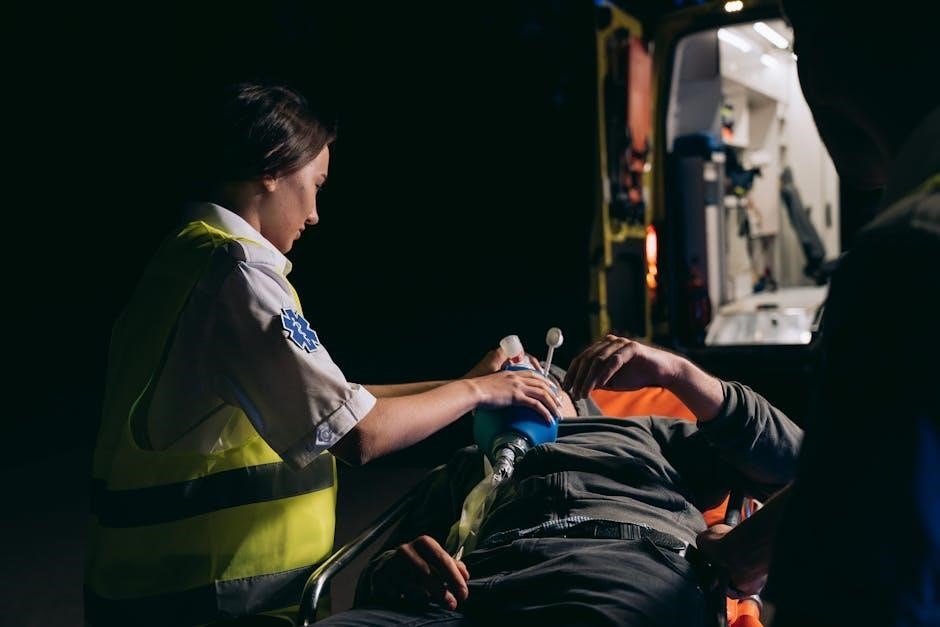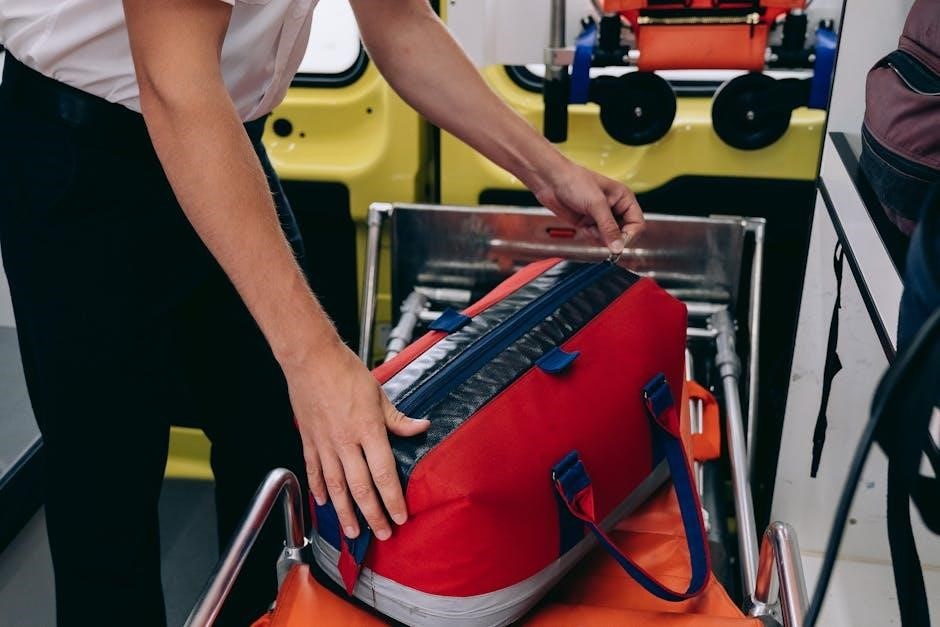The Emergency and Critical Care Pocket Guide is a vital resource, offering quick access to essential protocols for physicians, nurses, paramedics, and students. It provides concise guidance, updated with current best practices and standards.
1;1 Importance of the Pocket Guide in Emergency Medicine
The Emergency and Critical Care Pocket Guide is a concise, portable resource essential for rapid decision-making in high-stakes environments. It provides immediate access to critical protocols, ensuring healthcare providers can deliver timely, evidence-based care. Updated with current practices, it serves as a vital tool for physicians, nurses, and paramedics, enhancing efficiency and accuracy in emergency and critical care settings.
1.2 Target Audience: Physicians, Nurses, Paramedics, and Medical Students
The Emergency and Critical Care Pocket Guide is tailored for physicians, nurses, paramedics, and medical students, offering concise, evidence-based guidance. It serves as a quick reference for experienced professionals and a study aid for students, ensuring accurate decision-making in high-stakes environments. The guide’s portability and comprehensive coverage make it indispensable for all frontline healthcare providers.

Essential Skills in Emergency and Critical Care

Mastering ECG interpretation, rapid cardiac assessment, and BLS/ACLS protocols is crucial for effective emergency care, ensuring timely interventions and improved patient outcomes in critical situations.

2.1 Electrocardiogram (ECG) Interpretation
ECG interpretation is a cornerstone in emergency and critical care, enabling rapid assessment of cardiac function. The pocket guide provides clear, concise criteria for identifying ischemia, arrhythmias, and other abnormalities. Key components include P-wave, QRS complex, and T-wave analysis. Updated with current standards, it serves as a vital tool for frontline healthcare providers to make timely, accurate diagnoses and initiate lifesaving interventions.
2.2 Rapid Assessment of Cardiac Function
Rapid assessment of cardiac function is crucial in emergency and critical care. The Emergency and Critical Care Pocket Guide provides concise algorithms for evaluating cardiac status, including ECG interpretation and hemodynamic monitoring. It equips healthcare providers with quick reference points to identify and manage cardiac emergencies effectively, ensuring timely interventions and improved patient outcomes in high-stakes situations.
2.3 Basic Life Support (BLS) and Advanced Cardiovascular Life Support (ACLS)
The Emergency and Critical Care Pocket Guide provides clear protocols for BLS and ACLS, ensuring rapid assessment and intervention in cardiac emergencies. It outlines essential algorithms, drug dosages, and techniques for healthcare professionals, enabling effective management of cardiac arrest and critical cardiovascular conditions. This section is vital for paramedics, nurses, and physicians, offering a concise yet comprehensive guide to saving lives in high-pressure situations.
Airway Management
Airway management is critical in emergency care, focusing on techniques like endotracheal intubation, BVM ventilation, and managing difficult airways to ensure proper oxygenation and ventilation in critical situations.
3.1 Endotracheal Intubation Techniques
Endotracheal intubation is a critical skill in airway management, enabling secure ventilation. The Pocket Guide outlines pre-oxygenation, laryngoscopy, and tube placement. It emphasizes proper technique to minimize complications. Verification via capnography is stressed. The guide also covers difficult airways and alternative methods, ensuring providers are well-prepared for emergencies. Regular practice and adherence to updated protocols are essential for proficiency.
3.2 Bag-Valve-Mask (BVM) Ventilation
Bag-Valve-Mask (BVM) ventilation is a critical skill in emergency and critical care, enabling healthcare providers to assist patients with inadequate breathing. Proper technique involves ensuring a tight mask seal, using both hands to ventilate, and coordinating with an assistant to maintain the airway. The Emergency and Critical Care Pocket Guide provides clear, step-by-step guidance on BVM use, emphasizing the importance of adequate ventilation and troubleshooting common challenges.
3.3 Difficult Airway Management Strategies
The Emergency and Critical Care Pocket Guide provides evidence-based strategies for managing difficult airways, emphasizing rapid assessment and the use of tools like video laryngoscopy or supraglottic airway devices. It outlines troubleshooting techniques for failed intubations and offers guidance on when to escalate to surgical airway management, ensuring clinicians are prepared for high-stakes scenarios.

Breathing and Ventilation
Mechanical ventilation and oxygen therapy are critical in managing acute respiratory failure. The pocket guide provides evidence-based strategies for ventilation support, ensuring optimal patient outcomes in emergencies.
4.1 Mechanical Ventilation in Critical Care
Mechanical ventilation is a cornerstone in critical care, supporting patients with respiratory failure. The Emergency and Critical Care Pocket Guide provides clear guidance on modes of ventilation, initial settings, and patient-specific adjustments. It emphasizes the importance of synchronizing ventilation with the patient’s respiratory efforts and monitoring for complications like barotrauma or ventilator-induced lung injury. Proper weaning strategies are also outlined to ensure a smooth transition to independent breathing.
4.2 Management of Acute Respiratory Failure
Acute respiratory failure requires prompt intervention, focusing on oxygenation and ventilation. The Emergency and Critical Care Pocket Guide provides evidence-based strategies, including non-invasive ventilation and oxygen therapy. Assessment of respiratory mechanics and blood gases is crucial. The guide emphasizes the ABCDE approach, prioritizing airway and breathing stabilization. Early intervention and continuous monitoring are key to improving patient outcomes in critical care settings.
4.3 Oxygen Therapy and Non-Invasive Ventilation
Oxygen therapy and non-invasive ventilation are critical in managing respiratory distress. The pocket guide provides evidence-based protocols for titrating oxygen and using devices like nasal cannulas, Venturi masks, and BiPAP. It emphasizes monitoring oxygen saturation and clinical response, ensuring safe and effective therapy. These techniques are essential for stabilizing patients with acute respiratory failure, bridging to invasive ventilation when needed.

Circulation and Hemorrhage Control
Assessment of circulatory status and management of severe bleeding are critical. Techniques include tourniquet use and hemostatic agents to stabilize patients in emergency and critical care settings effectively.
5.1 Assessment of Circulatory Status
Assessing circulatory status involves evaluating blood flow, oxygen delivery, and organ perfusion. Key indicators include blood pressure, heart rate, capillary refill, and skin perfusion. The pocket guide provides a systematic approach to identify shock or hypoperfusion early, ensuring timely interventions. Vital signs and physical examination findings guide clinicians in determining the severity of circulatory compromise, enabling appropriate management strategies in emergency and critical care settings.
5.2 Management of Severe Bleeding and Shock
The Emergency and Critical Care Pocket Guide emphasizes rapid assessment and intervention for severe bleeding and shock. It outlines protocols for hemorrhage control, including tourniquet use and hemostatic dressings. Fluid resuscitation strategies are detailed, focusing on balanced approaches to maintain perfusion. The guide also covers shock classification and tailored interventions, ensuring clinicians can act swiftly to stabilize patients in critical conditions.
5.3 Use of Tourniquets and Hemostatic Agents
Tourniquets and hemostatic agents are critical in controlling severe bleeding. The pocket guide provides evidence-based guidance on their application, emphasizing proper techniques to minimize complications. It outlines when to use tourniquets, how to apply hemostatic dressings, and the importance of monitoring for adverse effects. This section ensures healthcare providers can effectively manage hemorrhage in emergency and critical care settings.
Assessment Tools and Techniques
The pocket guide emphasizes the ABCDE approach, Glasgow Coma Scale, and vital sign interpretation as critical tools for rapid, accurate patient assessment in emergency settings.
6.1 The ABCDE Approach to Patient Assessment
The ABCDE approach is a systematic method for assessing critically ill patients, focusing on Airway, Breathing, Circulation, Disability, and Exposure. This structured framework ensures comprehensive evaluation, prioritizing life-threatening conditions; It guides healthcare providers to identify and address issues promptly, improving patient outcomes in emergency and critical care settings.
6.2 Glasgow Coma Scale (GCS) for Neurological Assessment

The Glasgow Coma Scale (GCS) is a neurological assessment tool used to evaluate consciousness and brain injury severity. It assesses eye opening, verbal response, and motor function, with scores ranging from 3 to 15. Lower scores indicate severe impairment. Widely used in emergency settings, the GCS helps guide immediate treatment and predict patient outcomes, making it a critical component of neurological evaluation in critical care.
6.3 Vital Signs and Their Interpretation
Vital signs are crucial in emergency and critical care. The Pocket Guide offers a quick reference for assessing heart rate, blood pressure, respiratory rate, and oxygen saturation. It provides normal ranges and clinical significance, aiding in early detection of life-threatening conditions like shock or respiratory failure. This section ensures accurate interpretation, guiding timely interventions and improving patient outcomes significantly.
Common Emergency and Critical Care Scenarios
The pocket guide addresses cardiac arrest, trauma care, and acute stroke, providing evidence-based strategies for rapid assessment and effective management in high-stakes situations.
7.1 Cardiac Arrest Management
The Emergency and Critical Care Pocket Guide provides clear protocols for cardiac arrest management, emphasizing rapid assessment and intervention. It includes ACLS algorithms, defibrillation techniques, and medication dosing. The guide stresses the importance of high-quality CPR and timely defibrillation to improve patient outcomes. Regular updates ensure adherence to current guidelines, making it an indispensable tool for frontline healthcare providers.
7.2 Trauma Care and Injury Assessment
Trauma care requires rapid, systematic assessment using frameworks like ATLS. The pocket guide provides algorithms for evaluating injury severity, prioritizing interventions, and stabilizing patients. It emphasizes early identification of life-threatening conditions, such as hemorrhage or spinal injury, and outlines evidence-based management strategies to improve outcomes in critical situations.
7.3 Acute Stroke and Neurological Emergencies
The Emergency and Critical Care Pocket Guide provides essential protocols for managing acute stroke and neurological emergencies. It emphasizes rapid assessment, imaging requirements, and time-sensitive interventions. The guide includes specific guidelines for TIA, status epilepticus, and increased intracranial pressure (ICP) management, ensuring evidence-based practices are readily accessible for frontline healthcare providers.

Critical Care Topics
The pocket guide addresses sepsis management, acute kidney injury, and neurocritical care, providing evidence-based strategies for renal replacement therapy and brain injury management in critical settings.
8.1 Sepsis and Septic Shock Management
The Emergency and Critical Care Pocket Guide provides evidence-based strategies for managing sepsis and septic shock, emphasizing early recognition, fluid resuscitation, and antimicrobial therapy. It outlines the use of vasopressors and monitoring techniques to optimize patient outcomes. The guide also includes protocols for identifying high-risk patients and implementing bundled care approaches to improve survival rates in critical settings.
8.2 Acute Kidney Injury and Renal Replacement Therapy
The Emergency and Critical Care Pocket Guide provides practical guidance on managing acute kidney injury (AKI) and initiating renal replacement therapy (RRT). It outlines key strategies for early detection, fluid management, and electrolyte balance. The guide emphasizes evidence-based approaches to prevent progression and improve outcomes, serving as a vital resource for healthcare providers in critical care settings.
8.3 Neurocritical Care and Brain Injury Management
The Emergency and Critical Care Pocket Guide emphasizes evidence-based practices for neurocritical care, including brain injury assessment and management. It covers protocols for cerebral edema, traumatic brain injuries, and stroke, ensuring timely interventions. The guide also addresses monitoring techniques like ICP and cerebral perfusion pressure, providing practical strategies for optimizing neurological outcomes in critically ill patients.

Medication and Dosing in Emergency and Critical Care
The pocket guide provides evidence-based dosing for vasopressors, inotropes, analgesics, sedatives, and antimicrobials, ensuring precise and timely medication administration in critical situations, updated with current practices.
9.1 Vasopressors and Inotropes
Vasopressors and inotropes are critical medications in emergency and critical care, used to manage shock and cardiac dysfunction. Norepinephrine and epinephrine are common vasopressors, while dobutamine is a widely used inotrope. These agents enhance cardiac contractility and vascular tone, restoring adequate perfusion. Proper dosing and titration are essential, guided by hemodynamic monitoring to avoid adverse effects. The pocket guide provides evidence-based recommendations for their use in various clinical scenarios.
9.2 Analgesics and Sedatives in Critical Care
Analgesics and sedatives are crucial in critical care for pain management and patient comfort. Common medications include fentanyl, midazolam, and propofol. The pocket guide provides dosing recommendations, emphasizing the balance between effective sedation and minimizing respiratory depression. It also highlights the importance of individualizing therapy based on patient needs and monitoring sedation levels to ensure safety and optimal outcomes.

9.3 Antimicrobial Therapy in Sepsis and Infections
The Emergency and Critical Care Pocket Guide provides evidence-based recommendations for antimicrobial therapy in sepsis and infections. It emphasizes timely initiation, appropriate agent selection, and de-escalation based on culture results. The guide also highlights the importance of antimicrobial stewardship to reduce resistance and improve patient outcomes in critical care settings.
Special Populations in Emergency and Critical Care
The pocket guide addresses unique challenges in caring for pediatric, geriatric, and pregnant patients, providing tailored protocols and updated guidelines for these vulnerable groups in emergencies.
10.1 Pediatric Emergency and Critical Care
The Emergency and Critical Care Pocket Guide provides tailored approaches for pediatric emergencies, emphasizing weight-based medication dosing, respiratory support, and shock management. It addresses unique anatomical and physiological considerations in children, ensuring healthcare providers can deliver timely, evidence-based care in high-stakes situations.
10.2 Geriatric Emergency and Critical Care
Geriatric patients require specialized attention in emergency and critical care due to comorbidities, polypharmacy, and age-related physiological changes. The Pocket Guide emphasizes tailored assessments, focusing on functional status and geriatric syndromes. It provides evidence-based strategies for managing common conditions like falls, delirium, and cardiovascular diseases in elderly patients, ensuring age-specific care that improves outcomes and addresses end-of-life considerations.
10.3 Pregnant Patients in Emergency and Critical Care
Pregnant patients require specialized care due to physiological changes and fetal considerations. The pocket guide addresses unique challenges, such as managing ectopic pregnancy, preeclampsia, and trauma. It emphasizes modified assessment techniques, including fundal height measurement and fetal heart rate monitoring. A multidisciplinary approach, involving obstetricians and neonatologists, is crucial. The guide also covers the use of tocolytics and safe medication options during emergencies, ensuring both maternal and fetal well-being are prioritized.
Practical Resources and References
The Emergency and Critical Care Pocket Guide (8th Edition) and paramedic/EMT textbooks are essential resources. Online platforms like ETATNT offer reliable access to updated materials and guidelines.
11.1 The Emergency and Critical Care Pocket Guide (8th Edition)
The 8th Edition of the Emergency and Critical Care Pocket Guide is a trusted resource for physicians, nurses, and paramedics. It provides concise, evidence-based protocols for emergency and critical care situations. Updated with the latest medical practices, this guide ensures quick access to essential information, making it indispensable in high-stress environments. Its portability and comprehensive coverage enhance decision-making and patient care. ISBN: 9781284290325.
11.2 Paramedic and EMT Textbooks
Paramedic and EMT textbooks provide comprehensive training materials, complementing the Emergency and Critical Care Pocket Guide. These resources cover prehospital care, trauma assessment, and life-saving interventions. They are tailored for both students and experienced professionals, offering practical scenarios and evidence-based practices to enhance emergency response skills and patient outcomes in critical situations.
11.4 Online Resources for Emergency and Critical Care
Online resources like the Emergency and Critical Care Pocket Guide (8th Edition) and ETATNT provide accessible tools for healthcare professionals. These platforms offer downloadable guides, paramedic textbooks, and EMT resources, ensuring updated protocols and best practices are readily available. They cater to global needs, with listings and downloads accessible as of November 2024, supporting continuous education and emergency preparedness.
Future Directions in Emergency and Critical Care
Future directions emphasize integrating advanced diagnostic tools, telemedicine, and updated guidelines to enhance patient outcomes and streamline clinical decision-making processes effectively.
12.1 Advances in Diagnostic Tools and Technologies
Advances in diagnostic tools, such as portable ECG devices and AI-driven analysis, enhance rapid assessment in emergency and critical care. These technologies improve accuracy and speed, enabling timely interventions. The integration of real-time data and updated guidelines in resources like the Emergency and Critical Care Pocket Guide ensures clinicians stay informed, optimizing patient outcomes in dynamic settings.
12.2 Evolving Medical Practices and Recommendations
Medical practices in emergency and critical care continually evolve, with updates reflecting new evidence and technologies. The Emergency and Critical Care Pocket Guide incorporates these advancements, ensuring healthcare providers access the latest guidelines. Regular revisions align with changing recommendations, addressing emerging challenges and improving patient outcomes. This adaptability makes the guide indispensable for clinicians seeking current, evidence-based practices in dynamic care settings.
12.3 The Role of Telemedicine in Emergency and Critical Care
Telemedicine is revolutionizing emergency and critical care by enabling remote consultations, reducing response times, and improving access to specialists. It enhances patient outcomes through real-time monitoring and timely interventions, especially in underserved areas. However, challenges like technology barriers and data privacy must be addressed to fully integrate telemedicine into emergency care systems globally.
